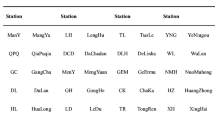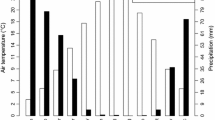Abstract
Soil temperature plays a critical role in many soil functions, particularly in arid ecosystems, but is scarcely reported as potential indicator of climate change. Although studies have been conducted worldwide to investigate (both measurements and modeling) temperature changes in the soil profile in response to ambient temperature, no information on soil temperature is available in the state of Kuwait. Hydrological and many bio-geochemical processes are more sensitive to soil temperature than air temperature. In this study, we used observed soil temperature data (2007–2016) from three sites with three soil depth increments (5, 50, 100 cm) and compared to regional climate and regression models’ output. The most salient finding of this study is the tight association between observed and simulated soil temperature at shallower soil depths from both the regional climate model (RegCM4) and linear regression model. The RegCM4 model poorly predicted (underestimated) soil temperature at deeper soil layers relative to shallower soil layers. Application of the linear scaling (LS) method has significantly improved the RegCM4 model performance with respect to measured soil temperature, which allows an accurate evaluation of the impact of climate change on the soil temperature under different soil management systems. These findings indicate that RegCM4 can be applied as a reliable predictor of soil temperature under arid ecosystems for which there is a gap in site data availability.





Similar content being viewed by others
Data Availability
The datasets generated during and/or analyzed during the current study are available from the corresponding author on reasonable request.
References
Riedel, T. (2019). Temperature-associated changes in groundwater quality. Journal of Hydrology, 572, 206–212.
Sen, C., & Ozturk, O. (2017). The relationship between soil moisture and temperature vegetation on Kirklareli City Luleburgaz District a natural pasture vegetation. International Journal of Environmental & Agriculture Research, 3, 21–29.
Jungqvist, G., Oni, S. K., Teutschbein, C., & Futter, M. N. (2014). Effect of climate change on soil temperature in Swedish boreal forests. PLoS ONE, 9(4), e93957.
Qi, J., Li, S., Li, Q., Xing, Z., Bourque, C., & Meng, F. R. (2016). A new soil-temperature module for SWAT application in regions with seasonal snow cover. Journal of Hydrology, 538, 863–877.
Ni, J., Cheng, Y., Wang, Q., Ng, C. W. W., & Garg, A. (2019). Effects of vegetation on soil temperature and water content: Field monitoring and numerical modelling. Journal of Hydrology, 571, 494–502.
Zhang, H., Wang, E., Zhou, D., Zhongkui, L. Z., & Zhang, Z. (2016). Rising soil temperature in China and its potential ecological impact. Scientific Report, 6, 35530. https://doi.org/10.1038/srep35530
Bullied, W. J., Flerchinger, G. N., Bullock, P. R., & Van Acker, R. C. (2014). Process-based modeling of temperature and water profiles in the seedling recruitment zone: Part I. Model validation. Agricultural and Forest Meteorology, 188, 89–103.
Luzuriaga, A. L., Sánchez, A. M., Maestre, F. T., & Escudero, A. (2012). Assemblage of a semi-arid annual plant community: Abiotic and biotic filters act hierarchically. PLoS ONE, 7(7), e41270.
Pal, J. S., & Eltahir, E. A. B. (2016). Future temperature in southwest Asia projected to exceed a threshold for human adaptability. Nature Climate Change, 6, 197–200.
Davidson, E., & Janssens, I. (2006). Temperature sensitivity of soil carbon decomposition and feedbacks to climate change. Nature, 440, 165–173.
Zhang, H., Yao, X., Zeng, W., Fang, Y., & Wang, W. (2020). Depth dependence of temperature sensitivity of soil carbon dioxide, nitrous oxide and methane emissions. Soil Biology and Biochemistry, 149, 107956.
Li, L., Zheng, Z., Wang, W., Biederman, J. A., Xu, X., Ran, Q., Qian, R., Xu, C., Zhang, B., Wang, F., Zhou, S., Cui, L., Che, R., Hao, Y., Cui, X., Xu, Z., & Wang, Y. (2020). Terrestrial N2O emissions and related functional genes under climate change: A global meta-analysis. Global Change Biology, 26, 931–943.
Mon, E. E., Hamamoto, S., Kawamoto, K., Komatsu, T., & Moldrup, P. (2016). Temperature effects on solute diffusion and adsorption in differently compacted kaolin clay. Environmental Earth Science, 75, 562–571.
Araghi, A., Mousavi-Baygi, M., & Adamowski, J. (2017). Detecting Ts trends in Northeast Iran from 1993 to 2016. Soil Tillage Research, 174, 177–192.
Brown, S. E., Pregitzer, K. S., Reed, D. D., & Burton, A. J. (2000). Predicting daily mean soil temperature from daily mean air temperature in four northern hardwood forest stands. Forest Science, 46, 297–301.
Yang, C. C., Prasher, O. S., & Mehuys, G. R. (1997). An artificial neural network to estimate soil temperature. Canadian Journal of Soil Science, 77, 421–429.
Zhu, J., & Liang, X. Z. (2005). Regional climate model simulation of U.S. soil temperature and moisture during 1982–2002. Journal of Geophysical Research, 110, D24110. https://doi.org/10.1029/2005JD006472
Godfrey, C. M., & Stensrud, D. J. (2007). Soil temperature and moisture errors in operational eta model analyses. Journal of Hydrometeorology, 9, 386–387.
Wang, L., Li, X., Chen, Y., & Yang, K. (2016). Validation of the global land data assimilation system based on measurements of soil temperature profiles. Agricultural and Forest Meteorology, 218–219, 288–297.
Qian, J. H. (2008). Why precipitation is mostly concentrated over islands in the maritime continent. Journal of the Atmospheric Sciences, 65, 1428–1441.
Qian, J. H., Robertson, A. W., & Moron, V. (2010). Interactions among ENSO, the monsoons, and diurnal cycle in rainfall variability over Java, Indonesia. Journal of the Atmospheric Sciences, 67, 3509–3524.
Giorgi, F., & Mearns, L. O. (1999). Introduction to special section: Regional climate modeling revisited. Journal of Geophysical Research: Atmospheres, 104, 6335–6352.
Giorgi, F., Pal, J. S., Bi, X., Sloan, L., Elguindi, N., & Solmon, F. (2006). Introduction to the TAC special issue: The RegCNET network. Theoretical Applied Climatology, 86, 1–4.
Hu, Y. X., & Stamnes, K. (1993). An accurate parameterization of the radiative properties of water clouds suitable for use in climate models. Journal of Climate, 6, 728–742.
Holtslag, A. A. M., & Boville, B. A. (1993). Local versus nonlocal boundary layer diffusion in a global model. Journal of Climate, 6, 1825–1842.
Emanuel, K. A. (1991). A scheme for representing cumulus convection in large-scale models. Journal of the Atmospheric Sciences, 48(21), 2313–2335.
Oleson, K. W., Dai, Y., Bonan, G., Bosilovich, M., et al. (2013). Technical description of the community land model. Boulder, CO: National Center for Atmospheric Research. Tech Note NCAR/TN-461+ STR, NCAR.
Anwar, S. A., Zakey, A. S., Robaa, S. M., & Wahab, M. M. (2019). The influence of two land-surface hydrology schemes on the regional climate of Africa using the RegCM4 model. Theoretical and Applied Climatology, 136, 1535. https://doi.org/10.1007/s00704-018-2556-8
Anwar, S. A., & Hejabi, S. (2023). The influence of different initial conditions on the soil temperature profile of Egypt using a regional climate model. Engineering Proceedings, 31(1), 62. https://doi.org/10.3390/ASEC2022-1385
Fang, G. H., Yang, J., Chen, Y. N., & Zammit, C. (2015). Comparing bias correction methods in downscaling meteorological variables for a hydrologic impact study in an arid area in China. Hydrology Earth System Sciences, 19, 2547–2559. https://doi.org/10.5194/hess-19-2547
Ngai, S. T., Tangang, F., & Juneng, L. (2017). Bias correction of global and regional simulated daily precipitation and surface mean temperature over Southeast Asia using quantile mapping method. Global Planetary change, 149, 79–90.
Xu, Z., & Yang, Z. L. (2012). An improved dynamical downscaling method with GCM bias corrections and its validation with 30 years of climate simulations. Journal of Climate, 25, 6271–6286. https://doi.org/10.1175/JCLI-D-12-00005.1
Luo, M., Liu, T., Meng, F., Duan, Y., Frankl, A., Bao, A., & Maeyer, P. D. (2018). Comparing bias correction methods used in downscaling precipitation and temperature from regional climate models: a case study from the Kaidu River Basin in Western China. Water, 10, 1046. https://doi.org/10.3390/w10081046
Rocheta, E., Evans, J. P., & Sharma, A. (2017). Can bias correction of regional climate model lateral boundary conditions improve low-frequency rainfall variability. Journal of Climate, 30, 9785–9806.
Mostafa, S. M., Anwar, S. A., Zakey, A. S., & Wahab, M. M. A. (2023). Bias-correcting the maximum and minimum air temperatures of Egypt using a high-resolution regional climate model (RegCM4). Engineering Proceedings, 31(1), 73. https://doi.org/10.3390/ASEC2022-1385
Dee, D. P., Uppala, S. M., Simmons, A. J., Berrisford, P., et al. (2011). The ERA-Interim reanalysis: Configuration and performance of the data assimilation system. Quarterly Journal of the Royal Meteorological Society., 137, 553–597.
Meng, X., Wang, H., Wu, Y., Long, A., Wang, J., Shi, C., & Ji, X. (2017). Investigating spatiotemporal changes of the land-surface processes in Xinjiang using high resolution REGCM43.5 and CLDAS: Soil temperature. Scientific Reports, 7, 13286.
Tabari, H., Talaee, H. P., & Willems, P. (2015). Short-term forecasting of soil temperature using artificial neural network. Meteorological Applications, 22, 576–585.
Bilgili, M. (2010). Prediction of Ts using regression and artificial neural network models. Meteorology and Atmospheric Physics, 110, 59–70.
Zhang, Y., Chen, W., Smith, S. L., Riseborough, D. W., & Cihlar, J. (2005). Soil temperature in Canada during the twentieth century: Complex responses to atmospheric climate change. Journal of Geophysical Research: Atmospheres, 110, D03112. https://doi.org/10.1029/2004JD004910
Fang, X., Luo, S., & Lyu, S. (2019). Observed soil temperature trends associated with climate change in the Tibetan Plateau, 1960–2014. Theoretical and Applied Climatology, 135, 169–181.
Araghi, A., Adamowski, J., Martinez, C. J., & Olesen, J. E. (2019). Projections of future Ts in northeast Iran. Geotherma, 349, 11–24.
Houle, D., Bouffard, A., Duchesne, L., Logan, T., & Harvey, R. (2012). Projections of future soil temperature and water content for three Southern Quebec forested sites. Journal of Climate, 25, 7690–7701.
Bradford, J. B., Schlaepfer, D. R., Lauenroth, W. K., Palmquist, K. A., Chambers, J. C., Maestas, J. D., & Campbell, S. B. (2019). Climate-driven shifts in Ts and moisture regimes suggest opportunities to enhance assessments of dryland resilience and resistance. Frontiers in Ecology and Evolution, 7, 358. https://doi.org/10.3389/fevo.2019.00358
Acknowledgements
The earth system physics (ESP) of the ICTP institute is acknowledged for providing the ERA-Interim dataset for conducting the simulation, which can be obtained from http://www.clima-dods.ictp.it/regcm4/. The source code of the RegCM-4.7.0 model can be downloaded from https://github.com/ICTP/RegCM/. We are also very grateful to Dr. Alfred Anderson, Associate Professor, Department of Food and Nutrition Sciences, Kuwait University, for proofreading the article and providing insightful comments. Similarly, we recognize the time and efforts of reviewers (anonymous) whose comments and constructive criticism helped sharpen the focus of the article.
Author information
Authors and Affiliations
Contributions
AE prepared the manuscript from data analysis and graphing to overall writing up of the manuscript; SA performed the regional model; HD collected the field soil temperature data. All authors read and approved the final manuscript.
Corresponding author
Ethics declarations
Ethics Approval
Not applicable.
Competing Interests
The authors declare no competing interests.
Additional information
Publisher's Note
Springer Nature remains neutral with regard to jurisdictional claims in published maps and institutional affiliations.
Rights and permissions
Springer Nature or its licensor (e.g. a society or other partner) holds exclusive rights to this article under a publishing agreement with the author(s) or other rightsholder(s); author self-archiving of the accepted manuscript version of this article is solely governed by the terms of such publishing agreement and applicable law.
About this article
Cite this article
Elmi, A., Anwar, S.A. & Al-Dashti, H. Measurements and Regional Climate Modeling of Soil Temperature With and Without Bias Correction Method Under Arid Environment: Can Soil Temperature Outperform Air Temperature as a Climate Change Indicator?. Environ Model Assess (2023). https://doi.org/10.1007/s10666-023-09945-7
Received:
Accepted:
Published:
DOI: https://doi.org/10.1007/s10666-023-09945-7




